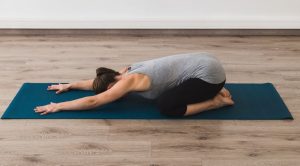Lower back pain can be a real drag, impacting everything from your daily activities to your overall mood. Whether you’re sitting at a desk all day or staying active with workouts, tightness and discomfort in the lower back can sneak up on anyone. But there’s good news! Incorporating stretching exercises into your routine is one of the best ways to alleviate tension and improve flexibility.
The right stretches not only help relieve discomfort but also promote better posture and prevent future injuries. If you’re ready to say goodbye to that nagging ache and embrace a more mobile lifestyle, this guide is for you. Get ready as we dive into ten fantastic stretching exercises specifically designed for the lower back. Let’s get those muscles moving!
Top 10 Stretching Exercises for Lower Back

1. Hip Circles
Hip circles are a simple yet effective way to warm up your lower back and hips. This exercise encourages flexibility and mobility, making it a perfect starting point for any stretching routine. Plus, it’s easy to perform anywhere.
- To do hip circles, stand with your feet shoulder-width apart. Begin by placing your hands on your hips for support. Start moving your hips in a circular motion, first clockwise. Make the circles as big or small as you feel comfortable while keeping the rest of your body still.
- After several rotations, switch directions and move counterclockwise. This shift engages different muscle groups and helps relieve tension throughout the lower back area. Remember to breathe deeply during this exercise; it promotes relaxation.
- Aim for 10-15 repetitions in each direction, focusing on smooth movements rather than speed. You’ll feel more limber in no time! Hip circles can easily be incorporated into both morning routines and post-workout cool downs for optimal results.
2. Windshield Wipers
Windshield wipers are a fantastic stretching exercise for the lower back. This dynamic movement mimics the action of windshield wipers, providing relief and flexibility to your spine. It’s simple yet effective.
- To start, lie on your back with your arms extended out to the sides. Bend your knees and keep them together while lifting them toward the ceiling. From this position, slowly lower both knees to one side, keeping them aligned. Feel that gentle rotation in your lower back as you breathe deeply.
- Hold for a moment before bringing your knees back up to the centre. Then, repeat the movement on the opposite side. Each repetition helps increase mobility in a safe manner. The key here is not to rush; take it slow and listen to how your body feels.
Incorporating windshield wipers into your routine can help alleviate tension and promote relaxation in those often stiff areas of the lower back. It’s an excellent way to enhance overall spinal health without any equipment needed.
3. Knees to Chest

Knees to the chest is a simple yet effective stretch for the lower back. This exercise helps alleviate tension and provides a gentle release for tight muscles. It’s perfect after a long day of sitting or standing, offering immediate relief.
- To perform this stretch, lie on your back with your legs extended straight. Bring one knee up towards your chest while keeping the other leg flat on the floor. Hold it gently with both hands, feeling the stretch in your lower back and hips. Switch sides after holding for about 20-30 seconds.
- You can increase comfort by adding variations like rocking gently side to side. This movement adds an extra massage effect to your lower back, enhancing relaxation even further.
Incorporate this exercise into your daily routine for better flexibility and reduced discomfort in that area. It’s quick, easy, and requires no special equipment—just you and some space on the floor!
4. Bridge Pose
Bridge Pose is a fantastic way to strengthen your lower back while enhancing flexibility. As you lie on your back, bend your knees and place your feet flat on the floor, hip-width apart. Your arms should rest comfortably at your sides, with palms facing down.
- Engaging your core, press into your feet and lift your hips towards the ceiling. This action helps open up the hips and stretches out tight muscles in the lower back. Hold this position for 20-30 seconds as you breathe deeply.
- Focus on maintaining a straight line from knees to shoulders. Ensure that you’re not overextending or straining; instead, find that sweet spot where you feel both challenge and comfort.
To release the Pose, gently lower your hips back down to the mat. Bridge Pose not only strengthens but also promotes blood circulation throughout the body, making it an essential addition to any routine aimed at relieving lower back tension.
5. Pelvic Tilts
Pelvic tilts are a simple yet effective stretching exercise for your lower back. They target the muscles in your abdomen and lower back, helping to improve flexibility and reduce tension. This movement is particularly beneficial if you spend long hours sitting.
- To perform pelvic tilts, lie on your back with your knees bent and feet flat on the floor. Place your arms at your sides or across your chest for support. Gently flatten your lower back against the floor by tightening your abdominal muscles while pushing down with your pelvis.
- Hold this position for a few seconds before relaxing into the starting posture. Repeat this cycle several times to create an even stretch throughout the lumbar region. You should feel a gentle release in that area as you practice.
This exercise not only helps alleviate discomfort but also strengthens core stability over time. Incorporating pelvic tilts into your routine can pave the way for better posture and reduced strain on the lower back during daily activities.
6. Cat-Cow
The Cat-Cow stretch is a gentle yet effective way to loosen up your spine and alleviate lower back tension. This dynamic movement engages both the front and back of your body, promoting flexibility while enhancing core strength.
- To perform this exercise, start on all fours in a tabletop position, ensuring your wrists are aligned with your shoulders and knees under your hips. As you inhale, arch your back downward while lifting your head and tailbone toward the ceiling—this is the “Cow” position.
- On the exhale, round your spine upward like an angry cat by tucking in your chin and tailbone. This motion helps release tightness along the entire spinal column. Transitioning between these two poses creates a soothing rhythm that can relieve stress as it stretches out key muscle groups.
Practising Cat-Cow regularly can improve posture by encouraging awareness of spinal alignment. It’s also beneficial for those who spend long hours sitting or engaging in repetitive movements throughout their day.
7. Child’s Pose

Child’s Pose is a gentle stretch that provides relief to the lower back while promoting relaxation. This restorative position allows you to gently lengthen your spine and open up the hips, making it perfect for anyone experiencing tension or tightness.
- To perform the Child’s Pose, start on your hands and knees. Spread your knees wide apart while keeping your big toes touching. Sit back onto your heels and extend your arms forward, resting your forehead on the ground. Breathe deeply as you sink into the Pose, letting gravity help release any lingering stress.
- This stretch not only calms the mind but also helps improve flexibility in the hips and spine. It encourages deep breathing, which can alleviate anxiety and promote mindfulness during practice.
Hold the Child’s Pose for 30 seconds to several minutes, depending on how it feels for you. It’s an excellent addition to any stretching routine designed specifically for lower back relief.
8. Spine Stretch
The spine stretch is a rejuvenating exercise that targets the back muscles and improves overall flexibility. It’s simple yet effective, making it perfect for anyone looking to relieve lower back tension. By focusing on elongating the spine, you can create space between your vertebrae, which often helps alleviate discomfort.
- To perform this stretch, sit comfortably with your legs extended in front of you. Sit up tall and inhale deeply. As you exhale, reach forward towards your toes while keeping your back straight. This motion encourages a gentle stretch through the entire length of your spine.
- Hold the position for several breaths, allowing each exhale to deepen the stretch slightly more without forcing it. You should feel a soothing pull across your lower back and hamstrings as you maintain proper form throughout.
This stretching exercise into your routine whenever you’re feeling tight or strained after long hours of sitting or standing. The spine stretch not only promotes relaxation but also enhances posture over time.
9. Corpse Pose
Corpse Pose, or Savasana is a fundamental yoga stretch that promotes deep relaxation. It may seem simple, but its benefits for the lower back are profound. By lying flat on your back and allowing your body to rest completely, you can release tension accumulated throughout the day.
- To perform Corpse Pose, start by laying on a comfortable surface. Allow your arms to rest at your sides with palms facing upwards. Keep your legs extended slightly apart and let them relax on the floor. Close your eyes and breathe deeply; focus on releasing any tightness in your lower back.
- This Pose encourages mindfulness while gently stretching the spine. As you remain still, it helps alleviate stress and improves blood circulation in the region. The calming nature of this Pose provides both physical and mental relief.
Corpse Pose into your routine can enhance overall flexibility in the lower back area while promoting better posture over time. It’s an excellent way to end any stretching session or practice, as it allows full-body integration of all previous movements.
10. Supine Twist

The Supine Twist is a gentle yet effective stretch for relieving tension in the lower back. By lying on your back and twisting your torso, you can target the muscles surrounding the spine, promoting relaxation and flexibility. This position helps to release tightness that often accumulates from daily activities.
- To perform this exercise, begin by lying flat on your back with your arms extended out to the sides. Bring one knee up towards your chest, then gently guide it across your body toward the floor while keeping both shoulders grounded. Feel the stretch as it unfolds through your spine and hips.
- Hold this position for several breaths, allowing gravity to deepen the stretch without forcing yourself into discomfort. Switch sides and repeat to ensure balanced relief across both areas of tension.
Incorporating Supine Twists into your routine can enhance spinal mobility over time. It’s an excellent way to unwind after a long day or as part of a morning warm-up before engaging in more strenuous activity.
Conclusion
Stretching exercises for the lower back are essential for maintaining flexibility and reducing discomfort. Integrating these movements into your daily routine can significantly improve your overall well-being. It’s important to listen to your body and practice each stretch mindfully.
Consistency is key when it comes to reaping the benefits of stretching. Aim to dedicate a few minutes each day or at least several times a week. This commitment will help you develop strength in your back muscles, promoting better posture and mobility.
Remember, everyone’s body is different. What works wonders for one person may not suit another perfectly. Personalize your routine based on how you feel after trying each exercise.
Don’t hesitate to consult with a healthcare professional if you’re unsure about which stretches are best for you, especially if you’re dealing with existing pain or injuries. Prioritize self-care as part of any fitness journey—your lower back will thank you!
FAQs
What are the benefits of stretching the lower back?
Stretching the lower back can alleviate tension, improve flexibility, and enhance overall mobility. Regular stretching also helps prevent injuries and promotes better posture.
How often should I stretch my lower back?
It is recommended to stretch your lower back at least 2-3 times a week, or daily if you’re experiencing discomfort. Consistent stretching can help maintain flexibility and reduce stiffness.
Can stretching relieve lower back pain?
Yes, stretching can significantly relieve lower back pain by reducing muscle tension and increasing blood flow to the area. Targeted stretches can also help correct muscular imbalances contributing to pain.
Should I consult a doctor before starting a stretching routine?
If you have chronic pain or underlying medical conditions, it’s advisable to consult a healthcare professional before starting any new exercise regimen. They can provide personalized advice based on your health status.
How long should each stretch be held?
Each stretch should typically be held for 15-30 seconds, depending on comfort levels. This duration allows the muscles to relax and lengthen effectively.
Are there any stretches I should avoid with lower back pain?
Yes, certain stretches like toe touches and excessive twisting can strain the lower back. It’s best to focus on gentle stretches and avoid those that exacerbate pain.
Can I do lower back stretches while sitting?
Absolutely! Many effective lower back stretches can be performed while seated, such as seated forward bends and seated torso twists. These are convenient options for office workers or those with limited space.

